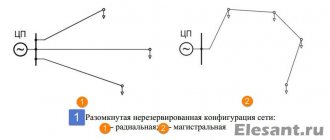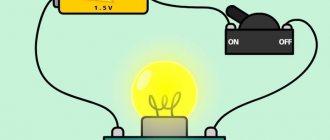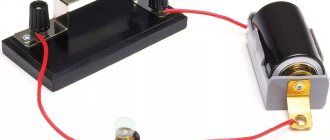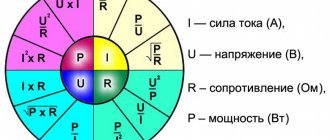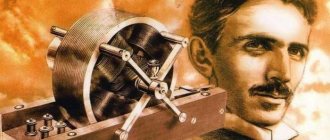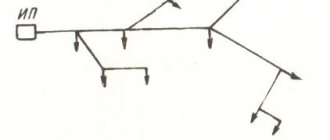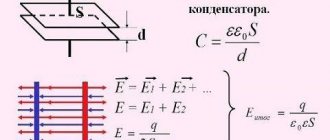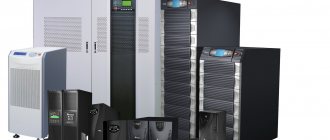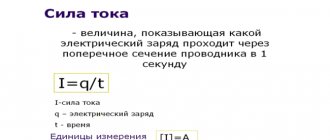Electricity. Basic Concepts
In this article, I suggest you remember the basic concepts in electrical engineering, without which any work related to electricity becomes problematic.
So, any electrical circuit is a collection of various devices that form a path for the passage of electric current. The simplest electrical circuit can consist of an energy source, load and conductors.
Conductors are substances that conduct electric current. They have low resistivity (that is, they offer the least resistance to the passage of current) and are able to conduct electric current with virtually no loss. The best conductors are gold, silver, copper and aluminum. The most widespread, due to the high cost of gold and silver, are copper and aluminum. Copper is the most common conductor, unlike aluminum, and has greater resistance to oxidation and physical influences: bending, twisting. The disadvantage of copper, compared to aluminum, is its higher cost.
In addition to conductors, there are also dielectrics - substances that have a high specific resistance to electric current (that is, they are non-conducting electric current). These include plastics, wood, textolite, etc.
One more type should also be noted - semiconductors . In terms of their resistivity, they occupy an intermediate position between conductors and dielectrics. The conductivity of these materials changes significantly under the influence of external factors. Semiconductors include many chemical elements, but the most common are silicon and germanium.
An energy source is a device that converts mechanical, chemical, thermal and other types of energy into electrical energy.
Load - a consumer of electrical energy, i.e. any electrical device that converts electrical energy into mechanical, thermal, chemical, etc.
The passage of electric current is only possible in a closed circuit.
, electric current is the directional movement of charged particles under the influence of an electric field created by a power source. The quantity characterizing the current is called current strength. Current strength is measured in Amperes and is designated by the letter A. There are direct and alternating currents.
Direct current (DC, in English Direct Current) is a current whose properties and direction do not change over time. Direct current and voltage are indicated in the form of a short horizontal dash or two parallel ones, one of which is dashed.
Alternating current (AC in English Alternating Current) is a current that changes in magnitude and direction over time. On electrical appliances it is indicated by a sine wave segment “~”. The main parameters of alternating current are period, amplitude and frequency.
A period is the period of time during which the current makes one complete oscillation.
Frequency is the reciprocal of period, the number of periods per second, measured in hertz (Hz).
The current and voltage in the load increase and decrease, and the difference between their minimum and maximum values is called amplitude .
Current measurement is carried out with an ammeter, which is connected in series with the load.
Any conductor in a circuit, depending on its cross-section, length, and material, resists the passage of electric current. The property of a conductor to prevent the passage of electric current is called resistance . Resistance is measured in Ohms (Ohms) .
The potential difference at the ends of the power supply is called voltage . Voltage is measured in Volts and denoted by the letter B (V) . In a three-phase electrical network, concepts such as linear and phase voltages are distinguished. Line voltage (or otherwise phase-to-phase) is the voltage between two phase wires (380V). Phase voltage is the voltage between the neutral wire and one of the phase wires (220V). The voltage is measured with a voltmeter, which is connected in parallel with the load.
Another important concept in electrical engineering is the concept of power . Source power characterizes the speed of transmission or conversion of electricity. Power is measured in Watts (W, W) .
The total power of all connected consumers is equal to the sum of the power consumed by each consumer. Рtotal = Р1+Р2+…Рn
There are concepts of active and reactive power. P - active power (effective), associated with that electrical energy that can be converted into other types of energy - thermal, light, mechanical, etc., measured in watts (W), represents useful power that can be used to perform work .
P = IUcosph - for a single-phase circuit, P = √3IUcosph - for a three-phase circuit, P = U*I - in a circuit where there is only active resistance.
Q – reactive power, associated with the exchange of electrical energy between the source and the consumer, measured in reactive volt-amperes (var), when the average power value for the period is zero, the active power is zero, the energy accumulated by the magnetic field of inductance returns back to the source, the current in the circuit does not do work, the reactive current uselessly loads energy sources and transmission line wires. Sources of reactive energy can be elements with inductance - electric motors, transformers. In order to reduce reactive power, capacitors are connected at the consumer terminals (series or parallel).
Q = IUsinф – for a single-phase circuit, Q = √3IUsinф – for a three-phase circuit
The phase shift between current and voltage is indicated by the angle φ. Power factor is the ratio of active power to total power, the value cosф is equal to the phase angle between voltage and current. The higher the cos φ, the less current is required to convert electricity into other forms of energy. This leads to a reduction in energy losses and energy savings.
That's all for now, and in the next part we will get acquainted with the basic laws of electrical engineering that any person connected with electricity needs to know.
Share on social media networks
By type of current
According to the type of current, all consumers of electrical energy are divided into three groups:
— Operating from AC mains, industrial frequency,
— Receiving power from a high-frequency alternating current network,
— From a direct current network, as well as from pulsed current sources.
The main type of current on which electrical installations of industrial enterprises operate is three-phase alternating current with a frequency of 50 Hz.
The converter of electrical energy from alternating current with a frequency of 50 Hz, into alternating current with a higher or lower frequency, or into direct current, is a consumer of electrical energy of three-phase alternating current with a frequency of 50 Hz.
By number of phases:
— Consumers of electrical energy are most often three-phase,
- According to the total load - single-phase,
— With a different number of phases, consumers receive power from a phase number converter, that is, from a three-phase network.
By frequency of supply current:
— Industrial frequency 50 Hz,
— Reduced frequency,
— High frequency up to 10 kHz,
— High frequency more than 10 kHz.
Most consumers of electrical energy receive power from an alternating current network with a frequency of 50 Hz.
Consumers with a reduced frequency include commutator electric motors used in mobile consumers of electrical energy for transport purposes at 16.5 Hz. Liquid metal stirrers 25 Hz, induction heating devices for casting large parts. A reduced frequency of the supply current is used in a number of mobile (seismic exploration) and portable (power tools) consumers of electrical energy.
Consumers of high-frequency electrical energy include electric motors in the textile industry for the production of rayon 133 Hz, individual electric tools, special machines on docks, a number of grinding machines in the bearing industry, to power high-speed electric motors 180 - 400 Hz. An increased frequency is used, mainly 400 Hz, including the use of frequency multipliers.
High frequency consumers
Up to 20 kHz for heating, melting metal, forging, stamping and pinning metal.
20 – 40 kHz for powering fluorescent lamps.
Up to 100 kHz surface clip installation.
Up to 20 MHz for heating semiconductor and dielectric materials.
In all the described cases, consumers of electrical energy are supplied through individual frequency converters, or converter substations.
To convert alternating current of a frequency of 50 Hz into alternating current of increased or high frequency, the following are used: a motor generator (EMU), as well as electronic (thyristor) or ion converters. Typically, to obtain an increased frequency of up to 140 kHz, thyristor converters and inverters are used, and for frequencies above 10 kHz, tube converters are used.
Properties of the converter: relatively low range of stable operation, limited by the rate of change of voltage and current (), relatively complex system of distribution of voltage and current among the elements - leveling for operation.
It is advisable to note that for a number of production mechanisms it is necessary to widely regulate the rotation speed, maintain a constant speed of the technological process, increased overload torque during PV operation, frequent reversal, rapid acceleration and deceleration, which necessitates the use of DC motors as electric drives. In addition, in electrolysis shops, electrolytic metal production, galvanizing shops and some types of electric welding equipment, there are also direct current consumers - when constructing a power supply circuit at an industrial enterprise, it is necessary to take into account the presence of direct current consumers, low or high frequency, and take into account individual converter installations in the power supply circuit and converter substations.
According to the type of current, all consumers of electrical energy are divided into three groups:
— Operating from AC mains, industrial frequency,
— Receiving power from a high-frequency alternating current network,
— From a direct current network, as well as from pulsed current sources.
The main type of current on which electrical installations of industrial enterprises operate is three-phase alternating current with a frequency of 50 Hz.
The converter of electrical energy from alternating current with a frequency of 50 Hz, into alternating current with a higher or lower frequency, or into direct current, is a consumer of electrical energy of three-phase alternating current with a frequency of 50 Hz.
By number of phases:
— Consumers of electrical energy are most often three-phase,
- According to the total load - single-phase,
— With a different number of phases, consumers receive power from a phase number converter, that is, from a three-phase network.
By frequency of supply current:
— Industrial frequency 50 Hz,
— Reduced frequency,
— High frequency up to 10 kHz,
— High frequency more than 10 kHz.
Most consumers of electrical energy receive power from an alternating current network with a frequency of 50 Hz.
Consumers with a reduced frequency include commutator electric motors used in mobile consumers of electrical energy for transport purposes at 16.5 Hz. Liquid metal stirrers 25 Hz, induction heating devices for casting large parts. A reduced frequency of the supply current is used in a number of mobile (seismic exploration) and portable (power tools) consumers of electrical energy.
Consumers of high-frequency electrical energy include electric motors in the textile industry for the production of rayon 133 Hz, individual electric tools, special machines on docks, a number of grinding machines in the bearing industry, to power high-speed electric motors 180 - 400 Hz. An increased frequency is used, mainly 400 Hz, including the use of frequency multipliers.
High frequency consumers
Up to 20 kHz for heating, melting metal, forging, stamping and pinning metal.
20 – 40 kHz for powering fluorescent lamps.
Up to 100 kHz surface clip installation.
Up to 20 MHz for heating semiconductor and dielectric materials.
In all the described cases, consumers of electrical energy are supplied through individual frequency converters, or converter substations.
To convert alternating current of a frequency of 50 Hz into alternating current of increased or high frequency, the following are used: a motor generator (EMU), as well as electronic (thyristor) or ion converters. Typically, to obtain an increased frequency of up to 140 kHz, thyristor converters and inverters are used, and for frequencies above 10 kHz, tube converters are used.
Properties of the converter: relatively low range of stable operation, limited by the rate of change of voltage and current (), relatively complex system of distribution of voltage and current among the elements - leveling for operation.
It is advisable to note that for a number of production mechanisms it is necessary to widely regulate the rotation speed, maintain a constant speed of the technological process, increased overload torque during PV operation, frequent reversal, rapid acceleration and deceleration, which necessitates the use of DC motors as electric drives. In addition, in electrolysis shops, electrolytic metal production, galvanizing shops and some types of electric welding equipment, there are also direct current consumers - when constructing a power supply circuit at an industrial enterprise, it is necessary to take into account the presence of direct current consumers, low or high frequency, and take into account individual converter installations in the power supply circuit and converter substations.
Electric current and its uses
Now we can say with confidence that the most important achievement of mankind is the discovery of electric current and its use.
Electrical energy is of great importance, both in the life of each individual person and in the development of modern society as a whole.
Today it is difficult to imagine our life without electricity. After all, it is what lights up our homes and streets, and sets trams, trolleybuses and trains in motion.
Yes, and all the household appliances we use at home operate using electrical energy.
The operation of modern means of communication, without which we cannot imagine our lives - telephone, radio, television, the Internet - is also based on the use of electrical energy.
Electricity has settled in all spheres of human activity. Neither industry, nor agriculture, nor even science can do without electricity.
Without it, the development of cybernetics, computer and space technology would have been impossible.
But it is important to understand that the electrical energy that we use does not exist in nature in a form ready for consumption. It cannot be extracted like a mineral - oil or coal.
So where does it come from?
In order for any energy to become useful to a person, he had to learn how to handle it, which means he had to learn to convert one type of energy into another.
Humanity has coped with this difficult task. People began to receive electrical energy, which is so necessary for industrial and domestic needs, from other types of energy: mechanical, thermal, light, chemical.
Conversions of various types of energy into electrical energy occur at power plants. A device that converts any energy into electrical energy is called a source
.
People obtain the bulk of electrical energy by converting mechanical energy using special electromechanical machines.
These machines are called electric generators
.
In an electric generator, the mechanical energy of the turbine is converted into electrical energy. A turbine
is a rotating wheel of a special design. For example, in hydroelectric power plants, the turbine rotates using the energy of falling water.
In thermal power plants, the turbine rotates using the energy of steam movement.
And at wind power plants - due to wind energy.
At space stations, the source of electrical energy is photocells. They are the ones who convert solar energy into electrical energy.
In addition to stationary sources, there are portable sources of electrical energy
. These are galvanic cells, various batteries, as well as batteries made from them.
In portable sources, electrical energy is obtained through the chemical process of interaction of dissimilar metals with a special substance - an electrolyte. There are also small-sized mechanical generators that operate using the muscular strength of a person’s arms or legs. An example of a small-sized mechanical generator is a bicycle headlight generator.
Let's try to figure out how the process of transferring electrical energy occurs.
In general, the first information about electricity appeared many centuries ago and then it related to electric charges that were obtained through friction. Even in Ancient Greece, it was established that if amber is rubbed with woolen cloth, it will acquire the ability to attract light objects.
By the way, in Greek the word “amber” sounds like “electron”. “electricity” comes from this word.
.
Then people found out that many other substances have exactly the same properties. Then such substances were called electrified
.
Now we say that bodies in this state have electric charges
, and we call the bodies themselves
charged
.
So, electrical energy is transmitted using a stream of tiny charged particles.
These charged particles always arise when different substances come into close contact. In some bodies, electrical charges can move freely between different parts, but in others this is impossible. In the first case, substances are called conductors
, in the second -
dielectrics
or
insulators
.
Conductors are all metals, solutions of salts, acids, including ordinary drinking water.
Examples of insulators include glass, rubber, and various plastics.
You should know that the division of substances into conductors and dielectrics is very arbitrary. Since all substances conduct electricity to a greater or lesser extent.
In nature, there are two types of electrical charges. Conventionally, they are called positive and negative.
Around each of these charges there is an electric field, due to which like charges repel each other, and unlike charges attract each other. In the case of interaction between different substances, unlike charges will tend to move from one substance to another. The movement of these charged particles will constitute an electric current.
In general, electric shock
called the ordered (directed) movement of charged particles under the influence of an electric field.
Historically, the direction of electric current was taken to be the movement of positive charges that move from the positive pole of the source to the negative along the conductor connected to the poles.
The number of charges passing per unit time through the cross section of a conductor is called current strength
.
This dependence is expressed by the following formula: , where is the current strength, is the number of charges, is time.
The unit of current is called the ampere.
, in honor of the French scientist Andre Ampère.
All electrical devices are supplied with constant
and
alternating current
.
Electric current, the direction and value of which does not change over time, is called constant
.
And an electric current, the direction and value of which can change periodically, is called variable
.
Most electrical devices are powered by alternating current.
Now let's look at the features of the flow of electric current in various environments and its application.
So, when considering the issue of the flow of electric current, it is necessary to take into account the presence of various current carriers - elementary charges - characteristic of a given physical state of a substance. The substance itself can be solid, liquid or gas.
In metal conductors, current is generated due to the movement of electrons having a negative charge. In general, all metals are current conductors. The application of current in metals is used to transmit electricity over a distance.
Among liquids, only electrolytes - solutions of salts, acids and alkalis - conduct electric current. The passage of direct electric current through liquid media is accompanied by chemical reactions. This property is widely used in batteries, in electrometallurgy for the production of aluminum and bauxite, as well as in the electrochemical processing of materials and the purification of metals from impurities.
An electric current in a gaseous medium causes the gas to glow. Fluorescent lamps, lasers, and spotlights operate on the basis of this phenomenon.
Devices that convert electrical energy into other types of energy - light, heat, mechanical and chemical energy - are called receivers
or
consumers of electrical energy
, and in electrical engineering -
load
.
In order for an electrical device (or load) to work, it must be connected to the poles of a current source. In practice, the source and load are often connected using additional conductors; in everyday life and electrical engineering they are called wires.
What we just talked about: the source of electrical energy, the load and the connecting wires - all together this is called an electrical circuit
.
Lesson summary
In this lesson we talked about electric current and its uses. We looked at various sources of electricity. We figured out how the process of transferring electrical energy occurs. We also looked at the features of the flow of electric current in various environments and its application.
